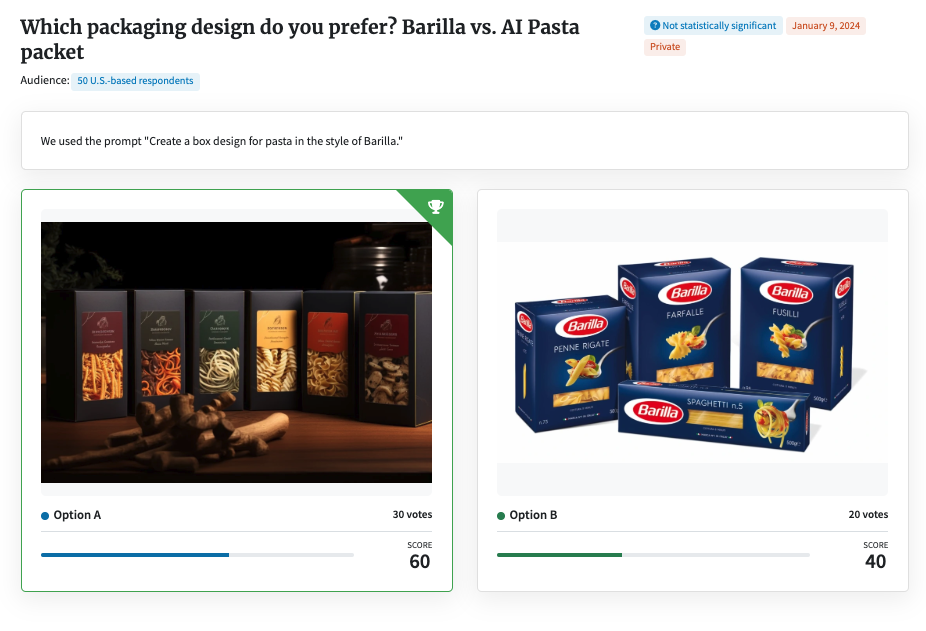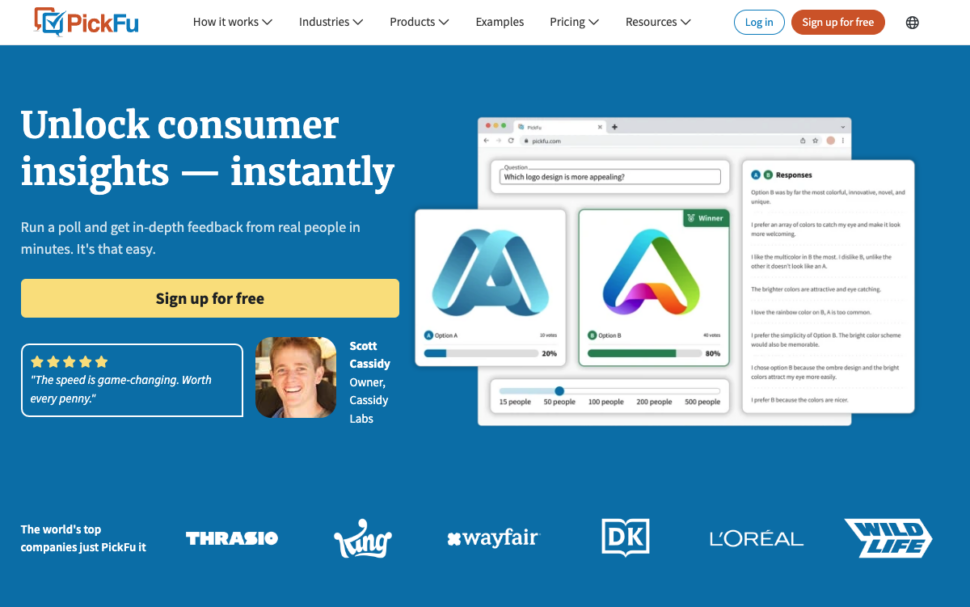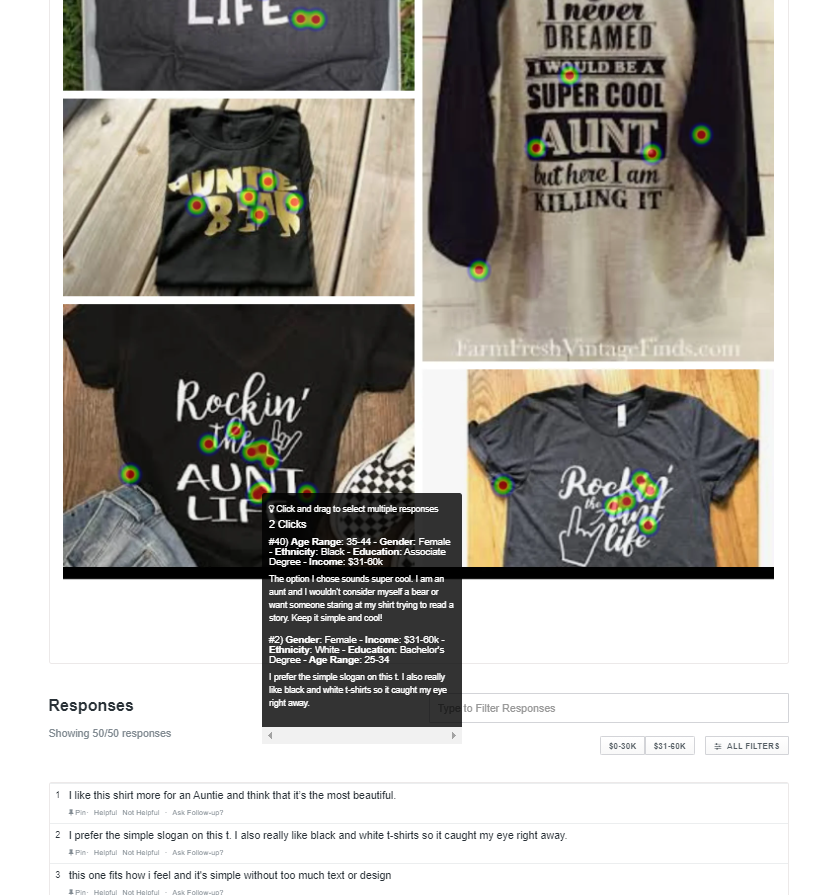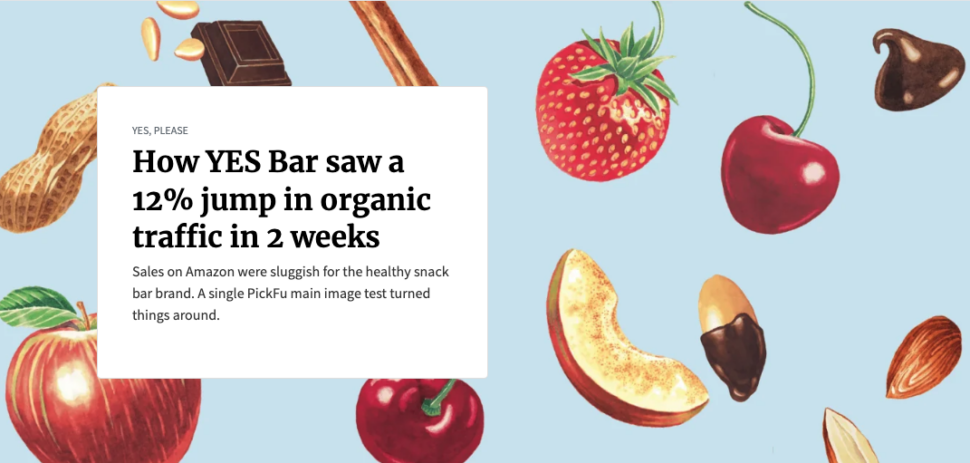Getting your product packaging right is just as important as perfecting the product itself.
A well-designed package catches your customers’ attention, makes a good first impression, and ensures the product is protected. And in a saturated marketplace, packaging can either drive sales or leave your product sitting on the shelf.
That’s why testing your product packaging is a crucial step to hitting your sales goals.
In this post, we’ll cover five package design testing strategies to help you get useful consumer feedback and optimize your packaging before you go to market.
Let’s get started!
What is package design testing?
Just like judging a book by its cover, customers judge products by their packaging. Think of all the times you’ve gone shopping and chose one brand over another because of how the package looked.
Something as simple as an eye-catching coffee package or tea packaging design might decide the brand you drink every day, for example.
Package design testing allows you to impact your target audience’s buying decisions by optimizing your packaging based on their preferences. It’s a form of market research done to understand what your audience wants and how they’ll perceive your product.
Testing empowers you to boost your new product’s packaging effectiveness, functionality, and appeal before you actually invest in developing and launching it.
You can (and should) test the following elements:
- The package’s color, typography, and visual elements
- The packaging structure and integrity (i.e. whether it protects the content from damage or holds well in storage)
- How practical and user-friendly it is (ease of opening, handling, storing, and disposing)
- Whether the design resonates with your target audience overall
By gathering data and insights on these elements, you can design a package that stands out on the shelf (physical or virtual) and helps drive more sales.
Why test packaging design?
A study by Ipsos found that 72% of Americans admit that a product’s packaging design influences their buying decisions. Sixty-seven percent of them purchase based on the retail packaging material, and eight in ten people focus on the package design when buying gifts.
By testing your packaging, you’ll get important insights that will inform your design process.
Packaging testing can help you:
- Choose the right typography and copy – packages have limited space for copy. With testing, you’ll identify the best font combination or messaging to drive purchases.
- Evaluate purchase intent – when customers see your product’s packaging, they visualize your product in their lives. You can influence people’s buying decisions and learn more about their purchase intent by testing their responses to your design.
- Test your branding – do you want to ensure that your packaging appears eco-friendly to reflect your overall brand image? Testing will help confirm whether your packaging matches your brand guidelines, identity, and values.
- Conduct concept testing – package design testing also involves proof of concept testing, where you test multiple designs or ideas at different stages. You’ll get customer feedback to fine-tune the final design before you commit to production.
It’s clear that gathering data before you finalize your design will give you a competitive edge. Now, let’s explore different strategies for testing package designs effectively.
5 packaging testing strategies to optimize sales
At PickFu, we’ve helped hundreds of businesses run fast, cost-effective package tests to get actionable insights during the packaging development process. Here are some approaches to testing. Choose the best strategy for your needs and resources (or use a combination of tests!)
1. Polls
PickFu is a self-service polling platform that instantly connects entrepreneurs, product developers, marketers, and more with their ideal customers. Simply upload your packaging designs, ask a question, choose your audience, and launch your poll – you’ll start getting feedback within minutes.
For example, a quick, easy way to test package designs in PickFu is to ask your target audience to choose between two or more design options. If one gets a majority of the votes, you’ll know which direction to take. Since respondents also provide written feedback, you can use the unique insights to guide the next stage of the packaging design process and refine your work.
Or how about conducting a shelf-impact analysis? Share images of your products on store shelves or a search results page, and ask your audience whether they’d buy them. This is a great way to tell whether your design stands out over the competition as well.
Polls are a simple but effective way to learn what works and what doesn’t in your package design concepts. Here are a few different types of PickFu polls you can try:
- Head-to-Head polls: Compare two or more design options against each other. The audience will vote for which one they like best (and explain why they chose it).
- Open-Ended polls: Ask your potential customers to give unfiltered feedback on a design. Ask what qualities respondents associate with your packaging design, for example, to test whether the package aligns with your brand identity.
- Ranked polls: Ask users to rank multiple design options in order of their preference, from best to worst. You’ll eliminate your least effective packaging concepts.
PickFu is built to help you validate concepts, iterate on designs, and launch optimized product packaging quickly and easily. We have a built-in, vetted panel of 15 million respondents globally that you can filter using 90+ demographic traits. Just sign up, launch your first retail packaging design test in minutes, and get results within hours.
This means you can move through the packaging development process – from validating concepts to iterating on designs to launching the best version – faster than most research methods. And you don’t need to spend thousands: polls start at just $15.
2. Heatmaps
Do you want granular information on the elements of your package design that attract (or repel) customers?
Heatmaps are an enlightening, cost-effective way to reveal the areas of your design that stand out to your audience. It’s one the best ways to identify elements that you should keep or alter based on consumer feedback.
Click Tests are a type of PickFu poll that generates a heatmap. Upload an image of your design, ask your audience a question (such as “Which area would you improve and why?”) and the audience will click on the spot they think needs the most work.
Within a few hours, you’ll get a heatmap that shows where the most people clicked on your packaging design. And you’ll get written feedback from each respondent about why they chose that area to click.
Your test users will catch mistakes that designers miss and will help you create a package that resonates with your ideal buyers.
Try this packaging evaluation poll Template to get a heatmap and fast audience feedback on your design.
3. Focus groups
There‘s an in-depth way to test your packaging design. That’s by discussing it with a group of your potential customers..
This is what a focus group does: it brings together representatives of your target demographic to learn about their opinions and attitudes toward your product packaging. And it’s usually in an offline setting.
You should use focus groups when:
- You want to create a benchmark to measure your design’s success
- You need qualitative feedback on your packaging’s brand messaging or emotional connection.
- You want to see how people interact with your packaging design in real-time.
- You plan to test multiple package design ideas.
This testing strategy helps you learn about the emotions, behaviors and motivations that drive purchasing behavior. You’ll identify weak points in your current package designand learn how well your new packaging aligns with your brand identity and values.
But when is a focus group unhelpful?
Focus groups may not be the best choice for every stage of the packaging and product design process. Here’s why:
- Lack of speed: Gathering a group of individuals and coordinating schedules can take weeks and can slow down the product development process – making it time consuming,
- Need for organization: Focus groups require significant planning and organization. From selecting a diverse yet relevant group of participants to preparing the discussion guide, every detail needs to be carefully planned and executed.
- Limited in scope: They usually consist of a small group of participants. The feedback you receive may not represent the opinions of your broader customer base.
- Cost-efficiency: They’re expensive. Not only do you have to pay for the venue and refreshments, but you also need to compensate the participants for their time.
Despite these issues, you can use focus groups to support your design testing. You can even run an online focus group by sharing images of your packaging via tools like PickFu.
4. Surveys
Surveys – a series of questions for a panel to answer – are another popular choice for testing packaging concepts and designs.
One option is to send physical products to a panel of users and ask them to respond to a survey later. This will help you assess the sturdiness, integrity, and experience of your packaging and choose the best materials to use.
Surveys can also help you spot patterns in responses over time. You’ll get insights to make smarter decisions during the entire testing process.
Online surveys are flexible and enable you to ask open-ended questions, use a Likert Scale, or take advantage of a variety of question and measurement types.
When should you use surveys?
Surveys are most effective when you need to test or ask about multiple aspects of your package design at once.
Say you want to learn about how people feel about all aspects of your packaging like color, material, or brand impact. Surveys will help you ask specific questions about each element and get more nuanced information. You can use this feedback to more easily meet people’s preferences and expectations.
Surveys are also useful when you’re in the later stages of the package design process where you can get information on packaging design as a whole.
When are surveys not the best choice?
Avoid using surveys when:
- You’re short on time. Surveys address multiple points at once so they need more time. And the longer the survey, the greater the survey abandonment rate.
- When it’s challenging to find a representative sample for testing your design.
- When you need quick feedback to make simple design choices.
The key to getting the best feedback for packaging testing is to use the best research method (or combination of methods) for your needs. Polls are better suited for “‘on-the-spot” feedback, while surveys are great for longer research timeframes.
5. Live A/B tests
The final testing method we recommend using is A/B testing.
Live A/B testing involves creating two versions of your packaging design (version A and version B) that differ in one specific way – color, typography, imagery, etc. – and testing both versions in the marketplace.
It’s important to change only one variable at a time to understand which version performs better and which element is responsible. For an example of how this works, look at how A/B testing can help choose a great supplement label design.
After you gather enough data, you’ll discover which version performs the best and use that one going forward.
When should you use A/B tests?
The goal of A/B testing is to learn which package design or element performs better. You’ll learn your audience’s specific preferences and what makes them more likely to buy your product.
There are two approaches to A/B testing: running live A/B tests (i.e. testing two different versions of your packaging in the marketplace) or A/B testing before you launch your product.
Live A/B testing, by definition, is done at the end of the design process while your product is available in the marketplace. It’s a great way to see how your packaging resonates in the real world.
A/B testing before you launch, meanwhile, helps ensure you make the right decisions about your design before you go to market. PickFu’s Head-to-Head polls are a form of A/B test, allowing you to compare and get feedback on two design options.
A/B testing is also quantitative, focused on getting the numbers behind your design performance. This makes it easy to compare results and speed up decision-making.
When are A/B tests unhelpful?
Live A/B testing works best when your designs are complete and you’re ready to see which one performs better in the real-world.
However, live A/B tests may not work well when you’re trying to learn about why people prefer one design over another or if you need feedback on multiple elements at once. Since the data you receive is largely quantitative, you won’t get deeper insights into consumer preferences.
In addition, when you run live A/B tests, you’re by default always showing a worse design to your audience – meaning you’ll miss out on sales. You also have to wait days or weeks (depending on your traffic) for enough data to make a decision on which design to choose.
That’s why using a combination of methods throughout the entire packaging design and development process is more effective.
Carry out easy package design testing with PickFu
Great packaging design can transform your business’s success – we should know, since we’ve helped hundreds of businesses run polls to validate and design great packaging. 😉
Check out some of our case studies to learn how our customers boosted their own conversions and sales with insightful feedback. For example, a healthy snack brand saw an 11.8% session increase that boosted their revenue in two weeks.
Test your package designs with PickFu today!
FAQs
How do you evaluate a packaging design?
You can evaluate packaging designs by testing different elements like color, font, graphic designs, aesthetics, and more against your target audience. Don’t forget to carry out package integrity testing to ensure all elements of your package design, including its shape and structure, work.
What is the purpose of package design tests?
Package design tests gather feedback and insights from consumers to optimize a product’s packaging design. The purpose is to ensure that the final packaging design effectively resonates with the target audience, driving sales and enhancing customer satisfaction. These tests can also identify areas for improvement or potential issues with the design before it reaches full-scale production.











